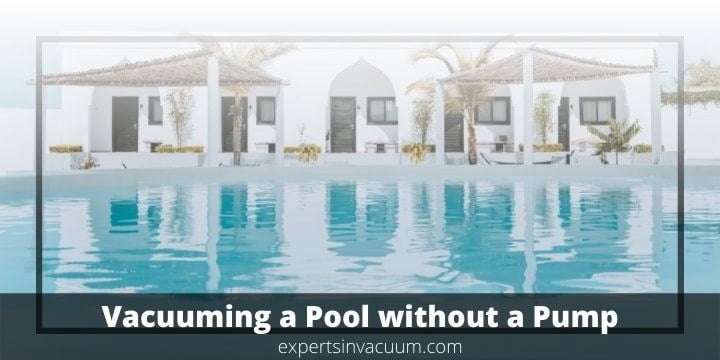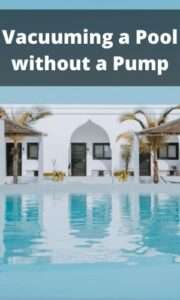It is critical to maintain your swimming pool in order to keep dirt and debris out. Using a pool pump is usually one of the methods of maintaining a pool because it circulates pool water and evenly distributes chemicals whenever it is used.
It prevents stagnation, which allows algae, dirt, and debris to thrive. It also provides the suction that your pool vacuum requires. However, even if you do not have a pool pump, you can efficiently vacuum your pool.

There may be times when you don’t have a pump or your pump is broken and you need to vacuum your pool. Therefore, the question is how to vacuum a pool without a pump. This article walks you through a step-by-step guide on how to vacuum a pool without a pump.
Continue perusing the article for more information on the subject matter.
In this post we will cover:
- How to Vacuum a Pool without a Pump
- Circulating the pool water without a pump
- How can you keep your pool clean without the pump?
- Why is it essential to vacuum your pool?
- What will happen if I do not clean my pool?
How to Vacuum a Pool without a Pump
It is vital to learn how to vacuum your pool without a pump, and below are some of the best methods for cleaning your pool without a pump:
Step 1: Assemble the equipment required, such as a vacuum plate, a telescopic pole, a flexible pool hose, and a flexible vacuum head.
Step 2: Attach the vacuum head to the telescopic pole side that is open so that the head of the vacuum can move around the pool’s bottom. Then use a hose clamp to attach one end of the hose to the upper part of the vacuum head.
Step 3: Place the hose together with the vacuum head on the pool’s floor while the other end of the hose remains outside the pool. Place one end of the hose against a jet return to remove any air in the hose.
Step 4: Remove the basket, which is the skimmers’ inner part, and block one end. Use your hand to block the water inside until it touches the skimmer’s bottom.
That will send bubbles through the vacuum head until the head is full, creating a suction. The suction will make the head tight and flat at the pool’s bottom.
Attach the vacuum plate to the opposite end of the hose, and similarly to the hose, block the opening and insert it into the skimmer.
Step 5: Begin vacuuming at the shallow end with long, slow strokes. As you approach the deeper end, where dirt is piling up, use shorter strokes that overlap to sweep the edges. End the vacuuming at the deeper end of the pool.
Step 6: Remove the vacuum head from the telescopic pole and attach a cleaning brush to it. Use the brush to scrub dirt, algae, and debris stuck on the pool’s sides.
Circulating the pool water without a pump
Using a siphoning hose: A siphoning hose is a plastic tube with two open ends used for drainage purposes to empty water from your pool.
The method requires a long hose such that one end will be completely immersed in the pool while the other end is attached to a faucet that is outdoors.
You can also fix the tube to a garden hose to lengthen it. Just ensure that the drainage end is lower than the hose’s other end. Then clean the pool as follows:
Step 1: When using the siphoning hose, submerge one end in your pool and attach the other end to an outdoor faucet.
Step 2: Once properly connected, turn on the faucet to allow a continuous flow of water into the pool.
Step 3: Lastly, when the pool is empty, allow fresh water to flow into it.
Using a shop vacuum: The shop vac is a great alternative to using the pool pump to remove water from your pool. The vacuum will take less time to drain your pool than the siphoning hose, which takes longer.
The vacuum will create a suction effect from the vacuum bag that is attached to the cleaner.
The vacuum is an automated device with an electric motor that spins a fan that sucks air into the vacuum bag. In doing so, a negative pressure buildup is created in the vacuum hose that pushes water right into the hose.
These are the steps to follow while using a shop vacuum to vacuum your pool without a pump:
Step 1: Ensure the vacuum hose is long enough to provide a reasonable distance between the vacuum and the pool. If the hose is short, you can increase its length by using a standard garden hose.
Step 2: Connect the hose to the vacuum and turn the machine on. Water will be sucked through the hose drainage by the vacuum straight into the debris bag.
Step 3: After completely draining the pool open, the debris bag will allow water to flow out. The method is compatible with both above-ground and in-ground pools.
Conclusion
A pool is a great place to relax and have fun, but it also comes with the responsibility of cleaning it. Regularly cleaning your pool will keep it in a healthy condition, and that includes vacuuming your pool.
When vacuuming your pool, a pump is an essential element in maintaining its cleanliness. However, what will you do if you do not have a pump or if yours has broken down? You will still need to vacuum your pool but without a pump.
As we have highlighted above, there are several ways of doing so, which are simple and can be executed without the help of a professional.
FAQs
What are the tips and tricks to vacuuming your swimming pool?
There is a lot required of you as a pool owner to maintain it, but having a simple routine will make it easy for you when it comes to vacuuming your pool. First, you should have a weekly vacuuming routine for your pool, and it will become part of your standard practice.
A pool vacuum will eliminate dirt quickly, preventing any major maintenance requirements.
Secondly, have the correct setup for your pool vacuum. That includes assembling the pool vacuum and selecting the filter valve setting based on the intensity level your pool vacuum needs. The filter setting is for light cleaning, but for heavy cleaning, use the “waste” setting.
Thirdly, have the correct equipment for vacuuming your pool. For instance, if your pool is lined with vinyl, make sure that your vacuum head has a soft brush to prevent wear and tear.
If the liner is made of granite or concrete, your vacuum head should have wheels to enhance smooth movement on the pool floor.
Your vacuum system should have several essential components, which include a vacuum head that suctions debris from your pool. A vacuum plate that connects the vacuum hose to the skimmer plate or inlet.
The vacuum should have interchangeable parts to allow you to reach every nook and cranny of your pool when cleaning. It should also have a vacuum head that connects the hose to the pool pump.
Lastly, clean up after you are done vacuuming your pool. Avoid leaving your vacuum in the pool because prolonged exposure will damage the device. Therefore, after every cleaning session, disconnect the vacuum and properly store the various parts.
If you used the waste setting, change the pump setting back to filter. Test the pH level of your pool water every time you vacuum to ensure the water is balanced.
How can you keep your pool clean without the pump?
There are ways of keeping your pool clean without a pump preventing the build-up of debris, residue, and scum. That can be done using the following steps:
Removal of debris: debris and organic material do not take long to begin collecting in a pool. When left unchecked, they will strain the surface of your pool. Therefore, skim and remove the debris using a pool vacuum, a skimmer, or a brush.
Sanitize your pool: sanitize the pool using chlorine because it keeps it clear, clean, safe, and sanitized. Focus on proper chlorine levels to avoid over-chlorination or the use of other balancing chemicals.
Typically, the chlorine level recommended is 1 to 3 parts per million (ppm). However, without a pump, the chlorine level should be maintained in the range of 3-4 ppm. To prevent algae growth, add an anti-algae agent to your pool.
Agitating and circulating: stagnant water is a breeding ground for gunk to thrive and for you to keep your pool clean, the water should be moving and circulating. You can use a submersible pump or robotic cleaner to move and circulate the water if you have electricity.
You can also use a brush to scrub the sides and bottom of your pool, as this will cause water to move and circulate in your pool.
Why is it essential to vacuum your pool?
When you own a pool, vacuuming is necessary to keep it clean and safe for use. Vacuuming your pool eliminates contaminants such as debris, dirt, algae, and mud that can build up in the pool, affecting the water’s pH balance.
The pool should be vacuumed every week to properly clean up the water in it and help in preventing the usage of more chemicals when cleaning. It will also prevent the collection of dirt and debris in the pool.
The regular vacuuming of the pool controls the pH level of the water. If your pool water is not clear, vacuum it as soon as possible, and more frequently if it is used more often. Clear, debris-free water helps in reducing the need for utilizing pool chemicals.
What will happen if I do not clean my pool?
Blockages, clogs, and expensive repairs: cleaning your pool saves you money that would have been used for expensive repairs and pool cleaning services.
Debris will build up and clog a pool’s filter or drainage when the pool is neglected. It will also damage the motor of the pool.
A dirty pool will make you sick: a pool that lacks proper care and maintenance may cause recreational water illnesses such as inflamed eyes and lungs, diarrhea, rashes, and respiratory infections.
If debris and dirt build-up, they cause slips and falls. If you neglect your pool, a thick oily film will form on the surfaces and walls of your pool.
That may cause even the most experienced swimmers to slip and fall because of the slipperiness. Keep the films and dirt at bay to keep your pool safe for users.
The pool will turn green: a neglected pool will take on a green, swampy appearance due to algae build-up. Fixing the pool means fixing the chemical balance of the water, which can be done by professional pool cleaning services.
After that, clean and maintain your pool to prevent the issue from re-occurring. Make sure your filter works properly to prevent a stagnant pool, which creates the conditions for algae to thrive.
